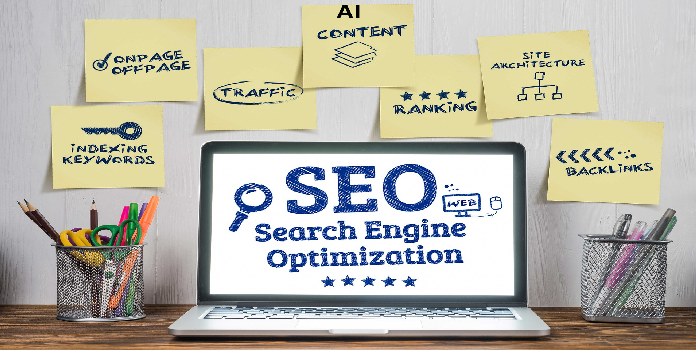AI writing tools have transformed the way content is created. However, not all AI content is created equal—especially when it comes to SEO. If you want your content to rank on the first page of Google, it must be SEO-optimized from the ground up. This post explores how to create SEO-optimized AI content that delivers real search engine visibility and drives organic traffic.
What Is SEO-Optimized AI Content?
SEO-Optimized AI Content refers to text generated by artificial intelligence tools that follows search engine optimization best practices. These practices include keyword integration, user intent satisfaction, readability, structure, and semantic relevance.
AI tools like ChatGPT, Jasper, and Copy.ai can assist in:
-
Keyword insertion
-
Content structure (H1, H2, bullets)
-
Meta tag creation
-
Internal linking suggestions
-
Readability and tone optimization
But AI alone isn’t enough. SEO-optimized AI content is the blend of AI efficiency and human oversight.
Benefits of Using AI for SEO Content
Leveraging AI for SEO content creation offers a powerful combination of speed, scalability, and precision. AI tools can quickly analyze search trends, suggest high-performing keywords, and generate well-structured content that aligns with user intent. This allows marketers and businesses to produce optimized content at scale while maintaining quality and relevance—ultimately improving visibility, engagement, and ranking performance on search engines.
🔍 1. Faster Content Production
AI can generate blog drafts, outlines, and even full articles within minutes—significantly speeding up your content calendar.
🧠 2. Data-Driven Insights
Some AI tools integrate with Google Search Console or keyword research platforms, helping you target the right topics.
✍️ 3. Consistency in Tone and Style
AI ensures uniformity across multiple pages or blog posts, keeping your brand voice consistent.
📈 4. Scalable SEO Strategy
Whether you’re running a blog or an e-commerce site, AI enables you to scale up content without hiring a full editorial team.
How AI Enhances On-Page SEO
Artificial intelligence plays a crucial role in improving on-page SEO by automating and refining key optimization tasks. From identifying high-impact keywords to structuring content with proper header tags, AI ensures your pages are aligned with search engine algorithms. It also helps maintain ideal keyword density, enhance readability, and suggest relevant internal and external links—all of which contribute to better rankings and improved user experience.
📌 A. Keyword Optimization
AI can naturally incorporate target keywords, LSI terms, and long-tail variations without overstuffing. Tools like Surfer SEO or Clearscope can be paired with AI for even better results.
🧱 B. Structural Best Practices
AI models understand the importance of proper formatting, like:
-
H1 for titles
-
H2/H3 for subtopics
-
Bullet points and numbered lists for clarity
🔗 C. Internal & External Linking
AI can recommend internal links to cornerstone content or relevant blog posts. It can also suggest authoritative external sources.
📝 D. Meta Tags and Snippets
AI can create optimized meta descriptions, titles, and featured snippets that increase click-through rates.
Choosing the Right AI Writing Tools
With countless AI writing tools available, selecting the right one depends on your specific content goals. Whether you’re crafting long-form blog posts, product descriptions, or ad copy, it’s important to choose a platform that aligns with your SEO needs, writing style, and integration preferences. Look for tools that offer keyword optimization, content scoring, and the flexibility to adjust tone and structure. The right tool should not only save you time but also enhance the quality and performance of your content in search engines.
🛠️ Recommended Tools:
-
Jasper AI: Ideal for marketing and blog content, includes SEO integrations.
-
ChatGPT (Plus or API): Flexible and cost-effective for any use case.
-
Copy.ai: Great for email, social, and ad copy.
-
Surfer SEO: Not an AI writer, but integrates with tools to provide real-time SEO scoring.
-
Frase.io: Combines AI writing with SERP analysis.
When choosing a tool, look for features like:
-
SEO integrations
-
Custom brand voice
-
Grammar and plagiarism checks
-
Multi-language support
Best Practices for SEO with AI Content
Creating high-ranking content with AI starts with combining machine efficiency and human strategy. While AI tools can speed up content creation, the key to SEO success lies in thoughtful planning, clear structure, and continuous optimization. By following proven best practices, you can ensure your AI-generated content not only reads well but also aligns with search engine algorithms and user intent.
✅ 1. Start with a Solid Content Brief
Before you use an AI tool, define:
-
Your primary keyword
-
Target audience
-
Tone of voice
-
Word count goals
-
Top-ranking competitors
✅ 2. Use AI to Generate, but Human to Edit
Even the best AI tools can produce generic or incorrect information. Always edit for accuracy, voice, and flow.
✅ 3. Optimize for Semantic Search
Google favors content that answers user intent. Incorporate related keywords, questions, and synonyms to improve contextual relevance.
✅ 4. Add Multimedia and Schema Markup
AI can suggest image or video placeholders. Complement content with alt text and use schema for:
-
Articles
-
FAQs
-
Reviews
✅ 5. Keep Content Fresh
AI makes it easier to update older posts with new stats or insights, helping you stay relevant and improve rankings.
Avoiding Common Pitfalls in AI-Generated Content
While AI tools can significantly accelerate the content creation process, relying solely on automation can lead to mistakes that hurt your SEO and credibility. It’s important to be aware of the limitations of AI, such as generating repetitive language, factual inaccuracies, or overly generic writing. To get the best results, always combine AI-generated content with human oversight to ensure quality, originality, and alignment with your brand’s voice.
⚠️ A. Keyword Stuffing
Don’t let AI overuse keywords. Use tools like Yoast SEO or Rank Math to monitor density.
⚠️ B. Plagiarism Issues
Always run AI content through a plagiarism checker (like Grammarly or Copyscape) before publishing.
⚠️ C. Lack of Originality
AI is trained on existing content. Inject original thoughts, stories, and data to stand out.
⚠️ D. Thin Content
Google penalizes low-value pages. Ensure each piece provides depth, insights, and unique perspectives.
Real-Life Examples and Case Studies
Real-world success stories help illustrate just how powerful AI-driven content can be when combined with smart SEO strategies. From bloggers scaling their publishing efforts to e-commerce brands dominating search rankings, these case studies show how businesses of all sizes are leveraging AI tools to achieve measurable SEO wins.
🎯 Case Study: E-commerce Site Boosts Organic Traffic by 70%
A mid-sized e-commerce store used Jasper + Surfer SEO to rewrite product descriptions and blog posts. Within 4 months:
-
Bounce rate dropped by 22%
-
Time on page increased by 35%
-
Organic traffic grew by 70%
🎯 Case Study: Blogger Scales Content 5x
A solopreneur used ChatGPT to create outlines, intro paragraphs, and summaries. By combining AI drafts with human editing:
-
Published 5x more content
-
Increased domain authority
-
Secured multiple featured snippets
Final Thoughts
AI writing tools are no longer just futuristic novelties—they’re essential content marketing allies. When used correctly, they can help create SEO-optimized content that ranks higher, drives traffic, and boosts conversions.
But remember: AI is a co-pilot, not the captain. The real magic happens when AI efficiency meets human creativity and SEO expertise.
🔄 Quick Recap: How to Rank Higher with AI Writing
| Strategy | Description |
|---|---|
| Use Target Keywords | Naturally embed your focus and LSI keywords |
| Create SEO-Friendly Structures | Use H1–H3 tags, lists, and readable formatting |
| Pair AI with SEO Tools | Integrate tools like Surfer SEO or Frase |
| Humanize the Output | Edit for tone, originality, and quality |
| Track and Iterate | Use analytics to refine future AI content |
💡 Pro Tip:
Don’t just publish AI content. Monitor its performance using Google Search Console, and tweak regularly to stay ahead of the algorithm curve.






